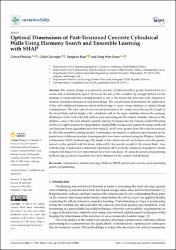| dc.contributor.author | Çakıroğlu, Celal | |
| dc.contributor.author | Bektaş, Gebrail | |
| dc.contributor.author | Geem, Zong Woo | |
| dc.contributor.author | Kim, Sanghun | |
| dc.date.accessioned | 2024-04-04T18:54:42Z | |
| dc.date.available | 2024-04-04T18:54:42Z | |
| dc.date.issued | 2023 | en_US |
| dc.identifier.citation | Çakıroğlu, C., Bektaş, G., Geem, Zong W., Kim, S. (2023). Optimal dimensions of post-tensioned concrete cylindrical walls using harmony search and snsemble learning with SHAP. Sustainability, 10 (15). | en_US |
| dc.identifier.uri | https://hdl.handle.net/20.500.12846/1036 | |
| dc.description.abstract | The optimal design of prestressed concrete cylindrical walls is greatly beneficial for economic and environmental impact. However, the lack of the available big enough datasets for the
training of robust machine learning models is one of the factors that prevents wide adoption of
machine learning techniques in structural design. The current study demonstrates the application
of the well-established harmony search methodology to create a large database of optimal design
configurations. The unit costs of concrete and steel used in the construction, the specific weight of
the stored fluid, and the height of the cylindrical wall are the input variables whereas the optimum
thicknesses of the wall with and without post-tensioning are the output variables. Based on this
database, some of the most efficient ensemble learning techniques like the Extreme Gradient Boosting
(XGBoost), Light Gradient Boosting Machine (LightGBM), Categorical Gradient Boosting (CatBoost)
and Random Forest algorithms have been trained. An R2
score greater than 0.98 could be achieved
by all of the ensemble learning models. Furthermore, the impacts of different input features on the
predictions of different machine learning models have been analyzed using the SHapley Additive
exPlanations (SHAP) methodology. The height of the cylindrical wall was found to have the greatest
impact on the optimal wall thickness, followed by the specific weight of the stored fluid. Also,
with the help of individual conditional expectation (ICE) plots the variations of predictive model
outputs with respect to each input feature have been visualized. By using the genetic programming
methodology, predictive equations have been obtained for the optimal wall thickness. | en_US |
| dc.language.iso | eng | en_US |
| dc.rights | info:eu-repo/semantics/openAccess | en_US |
| dc.subject | Optimization | en_US |
| dc.subject | Machine learning | en_US |
| dc.subject | XGBoost | en_US |
| dc.subject | SHAP | en_US |
| dc.subject | Prestressed concrete | en_US |
| dc.subject | Post-tensioning | en_US |
| dc.subject | Genetic programming | en_US |
| dc.title | Optimal dimensions of post-tensioned concrete cylindrical walls using harmony search and snsemble learning with SHAP | en_US |
| dc.type | article | en_US |
| dc.relation.journal | Sustainability | en_US |
| dc.identifier.volume | 15 | en_US |
| dc.identifier.issue | 10 | en_US |
| dc.relation.publicationcategory | Makale - Uluslararası Hakemli Dergi - Kurum Öğretim Elemanı | en_US |
| dc.contributor.department | TAÜ, Mühendislik Fakültesi, İnşaat Mühendisliği Bölümü | en_US |
| dc.identifier.startpage | 15 | en_US |

















